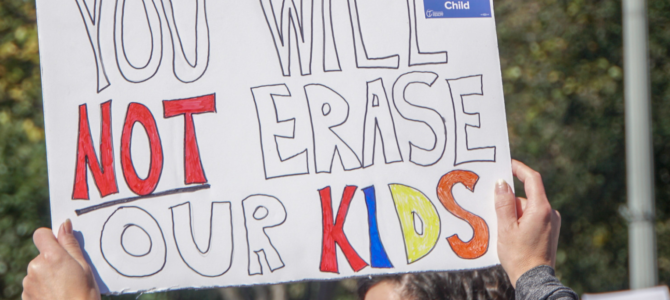
Although temporarily eclipsed by the COVID-19 pandemic, the transgender industry will ramp up again once the crisis has passed. Radical activists and their medical and pharmaceutical allies reap political and financial profit from preying on troubled children and adolescents — plying them with dangerous puberty-blocking drugs and cross-sex hormones, and wielding the scalpel to remove healthy organs and create nonfunctioning facsimiles of others.
Evidence mounts that these medical interventions increase the risk of stroke, heart disease, blood clots, cancers, and a host of other maladies no young person should ever have to face. They almost certainly result in infertility or sterility and put children on a lifelong path of medicalized warfare against their own bodies. Because there are no long-term studies of the effects of some of these interventions, they constitute a ghoulish experiment on confused but innocent kids.
Generally the trans industry must obtain parental consent before chemically or surgically altering the bodies of minors. But in light of the horrific known and potential consequences of the interventions, why would parents ever consent?
In most cases, as Maria Keffler recently explained in The Federalist, they give in because they’re being lied to. The industry emotionally blackmails them by warning that if denied access to experimental interventions, their children will kill themselves. The threat is so frequent, it has become a macabre cliché among trans-industry practitioners: “Would you rather have a live son or a dead daughter?”
Faced with this bleak choice, even sensible parents can be bullied into submission. But is that really the choice? Does evidence show that trans-identifying kids are uniquely at risk for suicide? Thankfully, no.
Suicide Among Trans Kids Is Rare
Any suicide is a tragedy, and all suicide threats must be taken seriously. However, suicide among trans-identified youth is rare, and comparable to that of other at-risk groups of youth, such as those with anorexia and autism. More importantly, there is no long-term evidence that puberty blockers, cross-sex hormones, or “transition” surgeries prevent suicide. On the contrary, the best long-term research shows that people who go through medical transition kill themselves at a rate many times greater than the general population.
Swedish child and adolescent psychiatrist Sven Roman, who is no conservative, sums up the research: “There is currently no scientific support for gender-corrective treatment to reduce the risk of suicide.” Psychologists Dr. Michael Bailey of Northwestern University and Dr. Ray Blanchard of the University of Toronto agree: “[T]he best scientific evidence suggests that gender transition is not necessary to prevent suicide. … There is no persuasive evidence that gender transition reduces gender dysphoric children’s likelihood of killing themselves.”
Bear in mind that in no other medical or psychological condition is a suicidal patient — let alone a child — allowed to dictate treatment. Children and adolescents are cognitively immature, and their thinking is further impaired under psychological distress. This is gross medical negligence.
Perspective is always helpful, and on this issue, the evidence shows that suicide risk among trans-identified youth is less than or comparable to that of other at-risk groups of youth:
- Being trans-identified increases suicide risk by a factor of 13
- Anorexia increases risk by a factor of 18-31
- Depression multiplies it by a factor of 20
- Autism raises the risk by a factor of 8
These figures are significant because youth with gender dysphoria often also suffer depression, anorexia, autism, and other psychological conditions predisposing them to suicide. Self-harm among trans-identified youth may be due to the dysphoria, but maybe not. It could stem from other psychological conditions or a combination of both. If that’s the case, radical chemical and surgical interventions administered to help the patient mimic the opposite sex won’t resolve the underlying psychological problem.
Suicide prevention for trans-identified youth is the same as for youth who suffer other psychological distress: talk therapy and Food and Drug Administration-approved psychiatric medications. As reported by the American Foundation for Suicide Prevention, “Ninety percent of people who die by suicide have an underlying — and potentially treatable — mental health condition.”
One study found that 96 percent of U.S. adolescents who attempt suicide suffer from at least one mental illness. There is no evidence trans-identified children who commit suicide are any different. In fact, the most up-to-date research shows the effectiveness of psychotherapy for resolving gender dysphoria in children and adolescents.
The Science Speaks for Itself
But what about studies arguing that medical interventions are more effective than psychotherapy in reducing suicides among trans-identifying youth? Objective medical researchers have dismantled those studies’ conclusions (see here and here for example). Problems found with these studies include unreliable sampling, manipulated numbers, and admitted political intent.
A report co-authored by the American Foundation for Suicide Prevention, which claimed that 41 percent of gender-dysphoric individuals have attempted suicide, was based on flawed data. Among myriad other problems, the study “did not directly explore mental health status and history, which have been identified as important risk factors for both attempted and completed suicide in the general population.”
In other words, the study provided no reliable information about whether suicide attempts were caused by gender dysphoria or by other mental-health issues. As one analyst of the study concluded, “Given the flawed data available to us, the leap in logic to assume the only viable choice is to medically transition or die ought to shame any provider, researcher, or journalist worth their salt.”
The conclusion of another study — supposedly finding that surgical “gender affirmation treatment” reduces psychological distress— is also sketchy at best. Dr. Mark Regnerus observed that the study’s own data didn’t support this conclusion.
Instead, Regnerus found that the study results signaled “an abandonment of scientific rigor and reason in favor of complicity with activist groups seeking to normalize infertility-inducing and permanently disfiguring surgeries. … Clinicians are being bullied into writing a radical prescription based on fear, not on sensible conclusions from empirical data.”
The politicized nature of research in this area is apparent from the policy statement of the American Academy of Pediatrics (AAP), which supports medical intervention rather than traditional psychotherapy and “watchful waiting” for trans-identifying youth.
Psychologist Dr. James Cantor found that AAP misrepresented myriad studies to justify its claim that medical transition is the best way to support these kids. “AAP’s statement,” Cantor reported, “is a systematic exclusion and misrepresentation of entire literatures.” In other words, AAP lied about the science.
The trans industry and its media collaborators insists that trans-identifying kids are driven to suicide by the societal stigma they face. But the leading study drawing this conclusion was so thoroughly debunked by the scientific community that the authors eventually retracted it. That major blunder hasn’t stopped trans radicals from clinging to the study’s conclusions and continuing to cite it as though it were still valid.
Psychiatrist Dr. Paul McHugh and epidemiologist Dr. Lawrence Mayer conducted an exhaustive review of all research on the topic of stigma-induced suicide and concluded, “[I]t is impossible to prove through these studies that stigma leads to poor mental health, as opposed to, for example, poor mental health leading people to report higher levels of stigma, or a third factor being responsible for both poor mental health and higher levels of stigma.”
Even without these studies, the argument that stigma drives trans-identified youth to suicide simply doesn’t make sense. Epidemiologist Hacsi Horvath — himself a “detransitioner” who accepted his sex after living 13 years as a woman — points out that the suicide rates for such adolescents were significantly lower in 1950, “when gender roles, sex-specific dress codes, laws regulating sexuality and other aspects of social control were much more rigidly ‘enforced’” than they are now. If social rejection didn’t cause suicide then, why would a much-diminished level of social rejection cause suicide now?
Transition Makes Matters Worse
Beyond the scant evidence that medical interventions reduce suicidality, the best evidence suggests that such interventions actually increase psychological distress.
As Bailey and Blanchard have reported, the two largest and most complete studies of suicide among trans-identifying patients found that those who did go through medical interventions had a much higher suicide rate than in the general population. These studies came from the Netherlands and Sweden, both socially liberal countries with little “stigma” directed toward transgenderism. The studies thus support the conclusion that “transitioning” merely masks the underlying psychological problems that are producing the dysphoria. It treats the symptoms rather than the disease.
Other research suggests that medical interventions can do more harm than good. Discussing an experimental trial of puberty blockers in the United Kingdom, Oxford University Professor Michael Biggs wrote that “after a year on [puberty blockers,] children reported greater self-harm, and … girls experienced more behavioral and emotional problems and expressed greater dissatisfaction with their body — so puberty blockers exacerbated gender dysphoria.”
Not only puberty blockers but cross-sex hormones may disrupt mental health. Women who identify as men receive megadoses of testosterone, enough to raise their levels 10-40 times above the female reference range. Past studies have documented multiple psychiatric problems — mania, hypomania, major depression, and even psychosis — with similar high doses of anabolic steroids like testosterone.
Estrogen also affects mood in complex ways. Post-menopausal women treated with even normal doses of estrogen often experience severe anxiety. Because men who identify as women receive megadoses of estrogen, this intervention could worsen both anxiety and depression.
Because administering puberty blockers and cross-sex hormones is such a recent phenomenon, there’s no long-term research about the medical and psychological consequences. But the trans industry seems unconcerned. Propaganda trumps science.
Don’t Be Bullied by Suicide Stunts
Tragically, suicide is prone to social contagion among young people. The more it’s discussed and predicted, the more likely troubled kids are to kill themselves. This self-fulfilling prophecy of transgender suicide is actually useful to the industry. It shapes the narrative. It frightens parents and legislators. It thus puts money in the bank.
The Federalist’s Casey Chalk has reported that industry collaborators such as Dr. Wallace Wong even encourage trans-identifying kids to threaten suicide to get what they want: “So what you need is, you know what? Pull a stunt. Suicide, every time, [then] they will give you what you need.” Wong added that trans-identified kids “learn that. They learn it very fast.”
Horvath calls out this manipulative use of the suicide threat:
The trans industry’s insistence and hype that [trans-identified adolescents] are constantly on the brink of transphobia-related suicide at rates that far exceed those of other highly relevant populations is a shameful social engineering strategy to keep society’s focus preferentially on transgenderism — perhaps to cast themselves as visionary pioneers in the field. … [T]rans activist adults and some clinicians effectively threaten suicide on behalf of the young people. They do this to socially-engineer, manipulate and intimidate non-industry doctors, politicians, community leaders and families of [these adolescents]. They are well aware of the emotional responses they will get with this rhetoric.
Faced with a suicide threat from their trans-identifying child, parents must take it seriously and get help immediately from a legitimate psychotherapist (i.e., one who isn’t affiliated with the trans industry). They shouldn’t, however, allow themselves to be bullied into agreeing to radical, experimental medical procedures they know deep down are bad for their child.
Those interventions aren’t the only option for handling the problem. They aren’t the best option. In a sane world, they wouldn’t be an option at all.









